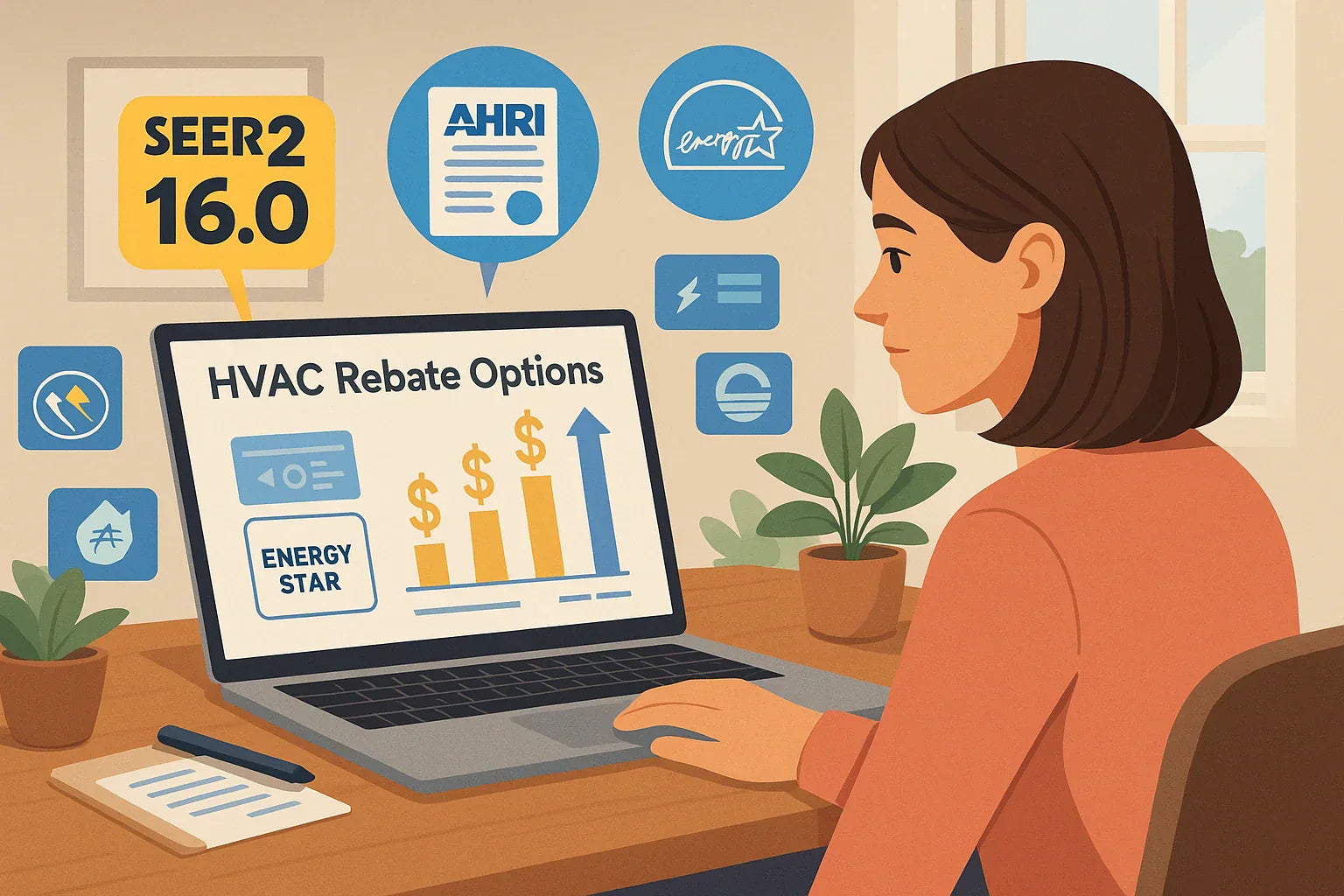By Alex Lane | Your Home Comfort Advocate
Upgrading your HVAC system isn’t just about comfort — it’s also a big financial decision. And in 2025, one of the smartest moves you can make is choosing a system that not only performs efficiently but also qualifies for rebates. The key to unlocking those savings? Understanding SEER2.
SEER2 isn’t just a buzzword — it’s the updated industry standard for measuring cooling efficiency, and it's now the baseline requirement for most federal, state, and utility rebate programs.
In this guide, I’ll walk you through how SEER2 affects your eligibility for HVAC rebates, how to take advantage of those incentives, and the steps to avoid missing out on thousands in potential savings.
🔍 What Is SEER2 and Why It Matters for Rebates
SEER2, or Seasonal Energy Efficiency Ratio 2, is the U.S. Department of Energy's (DOE) updated method for testing the efficiency of air conditioners and heat pumps. It replaced the original SEER rating system in 2023 and is designed to reflect real-world performance — including how airflow restrictions in your home impact system efficiency.
If you're new to SEER2, start here for the full breakdown:
👉 What is SEER2 and Why It Matters
Unlike the older SEER system, SEER2 uses stricter testing that better simulates typical home conditions. This makes it more accurate — and more relevant — for rebate programs that want to reward true energy savings.
💰 Types of HVAC Rebates Available in 2025
1. Federal Tax Credits: Inflation Reduction Act (IRA)
The Inflation Reduction Act (IRA) provides federal tax credits of up to $2,000 for qualifying HVAC systems. But eligibility hinges on your system’s efficiency:
-
Air conditioners typically need a minimum of 15.2 SEER2
-
Heat pumps must meet or exceed 15.2 SEER2 and 7.8 HSPF2
The IRS Clean Energy Tax Credit page provides an excellent summary of the latest qualifications.
2. State and Local Utility Rebates
Many homeowners also benefit from utility incentives layered on top of federal credits. For example:
-
Rebates may start at 15.2 SEER2
-
Higher rebates apply at 16.2 SEER2+ and higher HSPF2 thresholds
You can find state-specific offers by entering your ZIP code in the ENERGY STAR Rebate Finder.
3. Manufacturer Rebates
Top HVAC brands often run seasonal promotions for qualifying systems. Brands like Lennox, Carrier, and Daikin offer rebates during spring and fall promotions:
-
Lennox Promotions: Check current offers
-
Carrier Promotions: Explore limited-time deals
-
Daikin Promotions: See Daikin efficiency programs
These savings can often be stacked with government incentives.
✅ How to Qualify for Rebates Using SEER2
Step 1: Choose a SEER2-Compliant System
Your system must meet the 2025 regional SEER2 minimums to qualify:
-
North: 13.4 SEER2
-
South/Southwest: 14.3 SEER2 (<45k BTU/hr), 13.8 SEER2 (≥45k BTU/hr)
Step 2: Confirm Your Model’s Certification
To apply for rebates, you'll need:
-
The AHRI Certificate — This verifies the system’s SEER2, HSPF2, and EER2 ratings.
-
The EnergyGuide Label — Found on the unit itself, showing SEER2 clearly.
Use the AHRI Certified Directory to verify system performance.
Step 3: Gather the Paperwork
When you’re ready to apply:
-
Save your system purchase invoice
-
Get your contractor’s license number and installation details
-
Complete the rebate form for federal, state, or utility submission
⚠️ Common Mistakes That Could Disqualify You
1. Confusing SEER with SEER2
Only SEER2 ratings are accepted in 2025 rebate applications. Don’t assume a “16 SEER” unit qualifies — always confirm it’s SEER2.
2. Forgetting the AHRI Certificate
Without it, you may lose eligibility. It serves as proof of system match and testing.
3. Choosing a System Not Right-Sized for Your Region
If your system doesn’t meet minimum SEER2 based on location, it could fail inspection — or be disqualified entirely.
🔄 Can You Stack Rebates for Bigger Savings?
Yes — and it’s highly recommended. Smart homeowners combine:
-
Federal Tax Credit (up to $2,000)
-
Utility Rebates (typically $300–$1,000+)
-
Manufacturer Deals (up to $1,500)
Example: In a hot climate, installing a 16.2 SEER2-rated heat pump could yield:
-
$2,000 federal credit
-
$800 utility rebate
-
$1,200 manufacturer bonus
Total savings: $4,000 off installation
Looking for more local programs? Use the DSIRE database to browse state-by-state energy incentives.
🔍 Final Tip: Always Check Your Ratings
Before you sign off on a system, double-check that:
-
It meets your regional SEER2 minimums
-
You receive a copy of the AHRI certificate
-
The EnergyGuide label confirms SEER2 compliance
One missed detail could cost you hundreds in lost rebates.
💬 Final Thoughts from Alex Lane
Rebates are one of the few times the government, your utility, and even the manufacturer are all offering to give you money back — but only if your system meets SEER2 requirements.
So be proactive. Ask for documentation. Compare models. And remember: higher efficiency might cost more upfront, but it usually pays you back over time — especially if you can stack the right rebates.
Curious about how SEER2 came to be and why it replaced the old system? Start here:
👉 SEER2 vs. SEER: What’s Changed and Why It Matters
Alex Lane
Your Home Comfort Advocate







